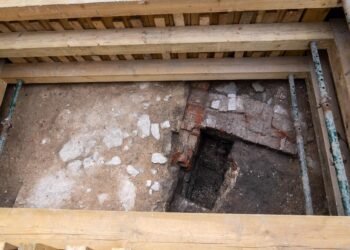Archaeologists in Warsaw have recently uncovered a mysterious tunnel system beneath Gucin Gaj, a historic park complex located in the Mokotów district, that has long been shrouded in speculation and folklore.

This barrel-vaulted U-shaped tunnel, which extends approximately 200 feet, lies near Wilanów Palace and St. Catherine’s Church and has ignited renewed interest due to its potential connections to the Freemasons and other historical uses dating back to the 17th century.
The Gucin Gaj estate, once part of the Royal Wilanów Palace grounds, has a rich history that intertwines with the legacy of Stanisław Kostka Potocki, a prominent Polish noble, statesman, and ardent Freemason. Potocki purchased the estate in the early 19th century and developed the park complex, naming it Gucin after his grandson, August.
Potocki was a key figure in Polish history, holding titles such as President of the Council of State in the Duchy of Warsaw and Minister of Religious Denominations and Public Education, where he championed social reform and education. His deep involvement in Freemasonry, eventually rising to the rank of Grand Master of the Grand National Orient of Poland, added an element of intrigue to the estate.

The tunnel itself, referred to in Poland’s official register of monuments as the “Masonic graves,” has fueled rumors that it served as a secret meeting place for Freemason ceremonies. Despite the absence of contemporary sources definitively linking the tunnel to Masonic rituals, the persistent legends and the catacomb-like niches found within the tunnel have only heightened curiosity. This folklore, combined with the estate’s historical significance, has made the site a focal point for both historical and archaeological research.
The recent excavation was led by the Institute of Archaeology of Cardinal Stefan Wyszyński University in collaboration with the Office of the Warsaw Conservator of Monuments. Archaeologists excavated a 5×5 meter area covering the entrance to the tunnel and part of the interior, revealing 19th-century walls that marked the entrance from Potocki’s time, along with earlier brick-built structures dating back to the 17th century. Among the findings were coins from the 17th century and relics from the early Middle Ages, which help establish a broader historical timeline for the site.
One theory suggests that the tunnel was originally part of a water cistern or icehouse constructed to supply the nearby Wilanów Palace. Records from Augustyn Locci, the court architect of King Jan III Sobieski, describe the construction of a water intake and icehouse on the northern slope of Góra Służewska, in the vicinity of Gucin Gaj. According to these records, the king himself tested the water and ordered it to be transported to Wilanów Palace to irrigate the gardens. The presence of a pond nearby supports the idea that the tunnel could have been used to store ice cut from the pond during winter, or as part of a water collection system.
After Potocki’s death in 1821, his wife Aleksandra transformed the estate into a commemorative grove, dedicated to the memory of her late husband. It was during this period that the tunnel gained its association with Freemasonry, a connection that has persisted despite the lack of concrete evidence.
The corridor has also been the subject of various local legends, including tales of it serving as a shelter during World War II and even rumors that it extended as far as Czersk. Today, the tunnel serves as a wintering spot for bats and has been designated a nature monument.
The excavation has unearthed significant findings, but much of the tunnel remains buried, leaving many questions unanswered. Ongoing research will aim to uncover more of the tunnel’s secrets, including whether it truly was a site for Masonic rituals or if its primary function was more utilitarian.























